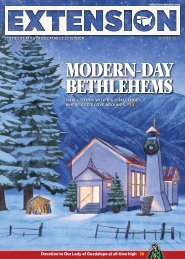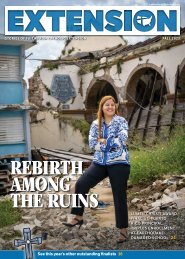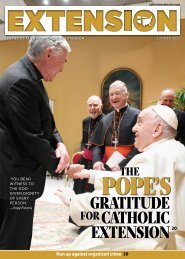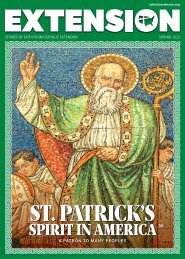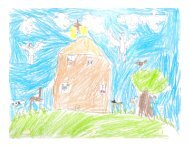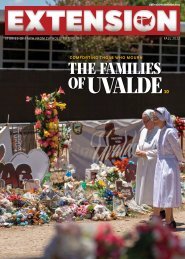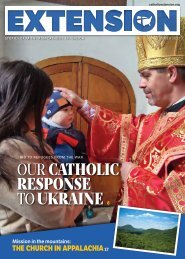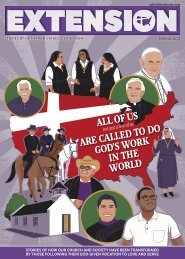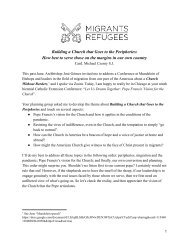Extension magazine - Spring 2024
What will be the impact of artificial intelligence on our world? Our article on page 24 considers how AI can assist as a helpful tool for the betterment of humanity, as well as its potential drawbacks. You will see images generated by a new AI system, Midjourney, that we prompted to create the cover of this magazine as well as vivid religious art. Also included is Pope Francis' 2024 address: "Artificial Intelligence and Peace."
What will be the impact of artificial intelligence on our world? Our article on page 24 considers how AI can assist as a helpful tool for the betterment of humanity, as well as its potential drawbacks. You will see images generated by a new AI system, Midjourney, that we prompted to create the cover of this magazine as well as vivid religious art. Also included is Pope Francis' 2024 address: "Artificial Intelligence and Peace."
Create successful ePaper yourself
Turn your PDF publications into a flip-book with our unique Google optimized e-Paper software.
16<br />
BUILD <strong>Extension</strong> | <strong>Spring</strong> <strong>2024</strong> 17<br />
Roots<br />
Religious priests served<br />
emancipated slaves<br />
in the South<br />
Deacon James Bryant<br />
preaches at Most Pure Heart of<br />
Mary Church in Mobile, Alabama.<br />
In 1909, <strong>Extension</strong> <strong>magazine</strong><br />
published the words of<br />
one of the first Black priests<br />
ordained in the United<br />
States, Father John Plantevigne,<br />
as he spoke at a<br />
missionary conference in<br />
Washington, D.C. “The Negro,” he<br />
said, “shall be treated as a man and<br />
not a problem.”<br />
His statement, sadly, would have<br />
been met with much skepticism<br />
by many Catholics at the time.<br />
The pastor belonged to St.<br />
Joseph’s Society of the Sacred<br />
Heart, better known as the Josephites,<br />
who stood in solidarity with<br />
the Black community. This order,<br />
which was originally founded in<br />
England, established its presence<br />
in the U.S. shortly after the Civil<br />
War to serve newly emancipated<br />
slaves. In the late 1800s the Josephites<br />
became an independent<br />
American Catholic order.<br />
For more than a century, Catholic<br />
<strong>Extension</strong> Society has supported<br />
the work of the Josephites<br />
as they minister to Black<br />
Catholics.<br />
At a time when seminaries<br />
refused to accept Black students<br />
and Southern Catholic<br />
churches followed Jim Crow laws,<br />
which forced many indignities<br />
upon Black Catholics, the Josephites<br />
took an alternative approach.<br />
<strong>Extension</strong> <strong>magazine</strong> printed letters<br />
from Josephite priests, hoping<br />
that their voices and perspectives<br />
would help change people’s hearts.<br />
For example, Father John J.<br />
In back, parishioners at St. Therese of Lisieux in Gulfport, Mississippi, welcome visitors. Front,<br />
from left to right: Father Tom Connery, pastor of St. Theresa in Belleview, Florida; visiting priest<br />
Father Michael Trail from Chicago; Bishop John Ricard, superior general of the Josephites; Bishop<br />
Louis Kihneman of Biloxi; and Marcia Wheatley, operations manager of St. Theresa in Belleview.<br />
Why many Black<br />
Catholics trace roots to<br />
Josephite parishes<br />
Albert, SSJ, in an article on how<br />
the Church discriminated against<br />
Black Americans, wrote, “The<br />
Church should be what it professes<br />
to be—Catholic. … It is not the private<br />
property of a single race—it<br />
is Catholic. As such, any tendency<br />
toward exclusiveness should be<br />
immediately booed. What right<br />
have we to make pharisaical distinctions<br />
in the House of God?”<br />
Close to the altar<br />
The Josephites established<br />
churches specifically for Black<br />
Catholics to provide worship<br />
spaces free of prejudice. Father<br />
Albert wrote that in these churches<br />
“the colored Catholic gives free<br />
scope to a growing Faith. The children<br />
sing in the choir; the boys<br />
serve on the altar and all of them<br />
have equal opportunities of seeing<br />
In 1909,<br />
<strong>Extension</strong><br />
<strong>magazine</strong><br />
shared the<br />
words of<br />
Father John<br />
Plantevigne,<br />
SSJ, one<br />
of the first<br />
Black priests<br />
ordained in<br />
the United<br />
States.<br />
and hearing and praying to their<br />
heart’s content.”<br />
The vision of the early Josephites<br />
came to fruition through their 150<br />
years of tireless, faith-driven work.<br />
They established parishes, schools,<br />
a seminary and an interracial community<br />
of priests. They founded<br />
what has become the largest Black<br />
Catholic fraternal organization of<br />
men and women in the country, the<br />
Knights and Ladies of Peter Claver.<br />
Their current superior general,<br />
Bishop John Ricard, SSJ, put<br />
it simply: “If not for the Josephites,<br />
there would be very few Black<br />
Catholics.”<br />
Catholic <strong>Extension</strong> Society has<br />
been working in solidarity with<br />
the Josephites, mostly in the Deep<br />
South, by helping to build or repair<br />
their churches, support religious<br />
education for children, and simply<br />
keep the doors of their vibrant<br />
parishes open.<br />
Empowering generations<br />
Following the Emancipation,<br />
millions of formerly enslaved people<br />
were forced to continue to<br />
labor in poverty in the fields without<br />
the means to improve their<br />
lives. “It was a huge challenge at<br />
the time,” said Bishop Ricard.<br />
In response, the Josephites<br />
opened the first Catholic schools<br />
for Black students. They worked<br />
with orders of women religious<br />
such as the Sisters of the Blessed<br />
Sacrament, founded by St. Katharine<br />
Drexel, to staff the schools.<br />
The community has served over<br />
170 parishes in over 35 dioceses<br />
throughout the U.S. The education<br />
and care provided in these missions<br />
transformed entire families<br />
and communities.<br />
The churches and schools gave<br />
their children, and their children’s<br />
children, a chance at a better<br />
life. Many prominent Black leaders<br />
today come from families that<br />
have been going to Josephite parishes<br />
for generations. Archbishop<br />
Shelton Fabre of the Archdiocese<br />
of Louisville, Kentucky, a prominent<br />
Black Catholic leader, grew<br />
up going to St. Augustine Church in<br />
New Roads, Louisiana. The church<br />
was founded by the Josephites in<br />
1922 and has been supported by<br />
Catholic <strong>Extension</strong> Society.<br />
The influence of the Josephite<br />
missions, which were largely<br />
based in the South, extends into<br />
the entire country. As millions of<br />
Black Americans moved north in<br />
the Great Migration, they took their<br />
faith with them. Today, Black Catholics<br />
across the country trace their<br />
roots back to Josephite-founded<br />
parishes.<br />
Passing the baton<br />
Josephite parishes today are<br />
places of light and joy in their<br />
communities.<br />
Bishop Louis Kihneman shepherds<br />
the Diocese of Biloxi, Mississippi,<br />
which includes six historically<br />
Black parishes, four of which<br />
were founded by the Josephites. “I<br />
just love to celebrate with them,”<br />
he said. “They really bring a tradition<br />
of faith, which I think in many<br />
ways helps us as a Church at large<br />
to stay alive in the spirit, because<br />
they’re very spirit filled.”<br />
In January of this year he celebrated<br />
Mass at St. Peter the Apostle<br />
Church. The parish’s church was<br />
completely destroyed in Hurricane<br />
Katrina in 2005. In 2018, Catholic<br />
<strong>Extension</strong> Society helped construct<br />
a new church—modeled after the



